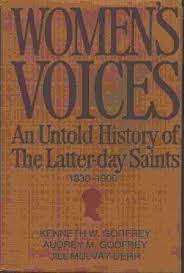Articles/Essays – Volume 16, No. 2
Voices from the Dust: Women in Zion | Kenneth W. Godfrey, Audrey M. Godfrey, and Jill Mulvay Derr, Women’s Voices: An Untold History of the Latter-day Saints 1830-1900
The subtitle of this book indicates its primary shortcoming. This is, indeed, one more history of the Mormons. The chapter headings could be those of any similar work giving a general overview of the growth of the church in America: “Becoming a Mormon,” “Kirtland,” “Missouri,” “Nauvoo,” “The Trek Westward,’ “Immigration,” “Colonization of the Great Basin,” “The 1870s: A Decade of Collective and Personal Achievement,” and finally “Persecution, the Manifesto, and Statehood.” Though the subtitle claims that this is an untold history, in fact, the story we have is one we have heard many times; and it is not substantially different because it is being told by women. We must ask the question: What do we have in this book that we did not have in others? What have we learned that we did not know?
We must applaud the book on two counts: it does use the journal and letter genres to tell the story, and that is encouraging, giving these forms more attention than they have hitherto had; and it does record the voices of twenty-five women and make a start toward acknowledging women’s roles in the settling of Zion. Certainly, getting bits of their stories between book covers does something towards greater recognition for our Mormon foremothers. But the significant question is: How much real understanding has been generated through Women’s Voices?
Perhaps the problem is suggested in the introductory quote, “Upon these we bestow more abundant honour,” taken from 1 Corinthians. It reveals the editorial bent of the book, and with that bent, its short comings. The women whose voices are heard here are, in the eyes of the editors, Latter-day Saints first, and women second. While this is a legitimate perspective, it is a perspective which determines the selection of material and, thus, the vision that results. The effort is to honor the valiant of Zion—this time the women. There is nothing wrong with that; yet had Women’s Voices been weighted more toward understanding and less toward “honor,” the book might have been more useful.
I have read Mormon women’s journals and letters, and found therein a rich diversity of tone, attitude, experience, perception, and life view. That diversity is missing from Women’s Voices, even though it covers a wide span and includes a wide cross section of women. The reader who comes to Women’s Voices to gain new insights about the experiences and inner lives of nineteenth-century Mormon women will find instead a concentration on the spiritual aspects of their lives. This concentration produces its beauties, but will not satisfy a scholarly interest in women’s history. (See, for example, Joanna L. Stratton, Pioneer Women: Voices from the Kansas Frontier, published by Simon and Schuster, 1981).
In so saying, I must point out that the introductory essay, though brief and general, comprehensively identifies important common themes that emerge from the manuscripts. The role of the journal or of letters as “an outlet for frustration and grief” surely bears intensive examination in the plentiful private writings of Mormon women. The reality that Mormon women worked for pay is underscored, another subject meriting fuller exploration. The editors’ observation that these women “lived much of their lives in a subculture separate from men” (p. 9), could well have formed the organizing principle for the entire book. Interestingly, they note that “plural wives seem to be disproportionately represented among Mormon women whose writings have been preserved in archival collections.” They theorize that these women “heeded the commandment to keep per sonal records as diligently as they heeded the commandment to enter into plural marriage. Or perhaps they or their posterity or archivists sensed the uniqueness of the experience and sought to preserve it.” This correlation deserves a great deal more attention. Indeed, one who reads even minimally in the diaries and letters of nineteenth-century Mormon women soon discovers that the great story of polygamy is yet to be told. Surely this portion of our history deserves book-length treatment of its own without either apology or sensationalism.
The editors should also be commended for selecting materials that are truly primary and alive with immediacy. There are a few after-the-fact selections: Mary Ann Weston Maughan’s from an autobiography written in the 1890s, Martha Cragun Cox’s, from an autobiography written in 1929, and Drusilla Dorris Hendricks’s from a reminiscence dictated “sometime in the 1870s,” giving an account of the years 1836-37. The rest, however, are from letters and diaries written in the white heat of the experience, and thus, from a scholarly perspective, of greatest value: Bathsheba B. Smith’s lonesome Nauvoo letters to her missionary husband, George A., and Julina Lambson Smith, very pregnantly on a mission—mostly housework—with Joseph F. in Hawaii.
The details of the manuscripts them selves are always worth reading. The honest, straightforward personal accounts of physical suffering, death of loved ones (especially infants and very small children), endurance in the face of privation and loneliness, and the bonding of women to mothers, sisters, daughters, and friends, along with tested dedication to the gospel are deeply moving. The selections are shorter than some might wish, but the editors chose to have breadth rather than depth. Given their perspective, that was probably the better choice.
Women’s Voices: An Untold History of the Latter-day Saints 1830-1900, by Kenneth W. Godfrey, Audrey M. Godfrey, and Jill Mulvay Derr (Salt Lake City, Utah: Deseret Book Company, 1982)), 448 pp. including chapter notes and index, $9.95.


 Back to full Issue
Back to full Issue

